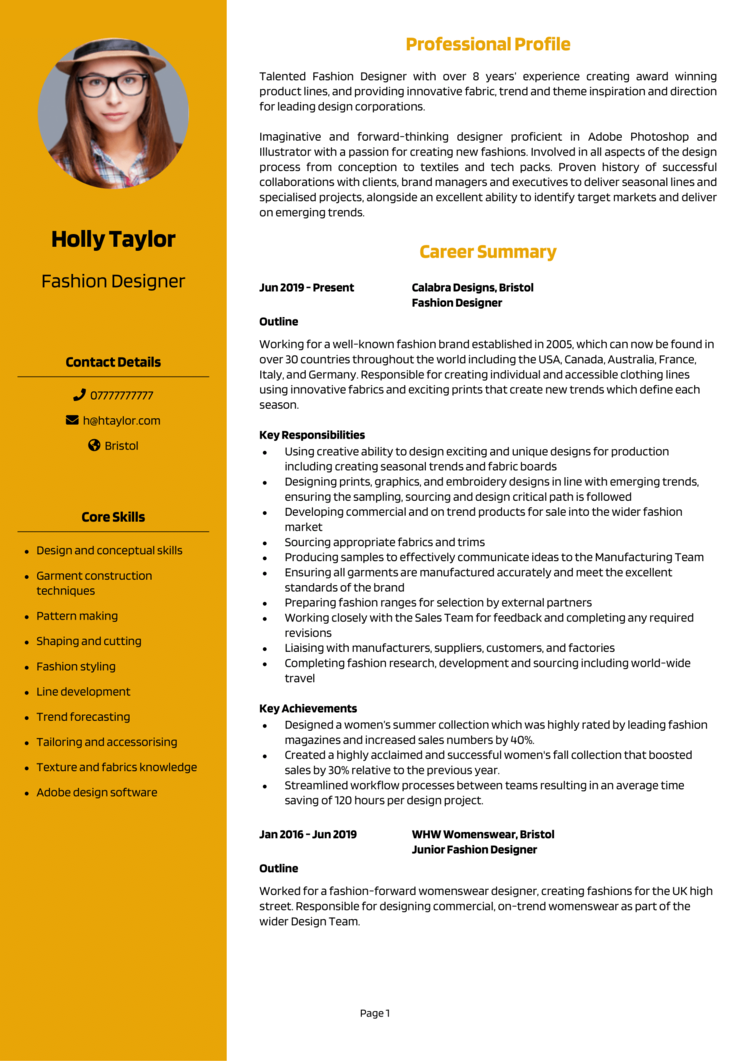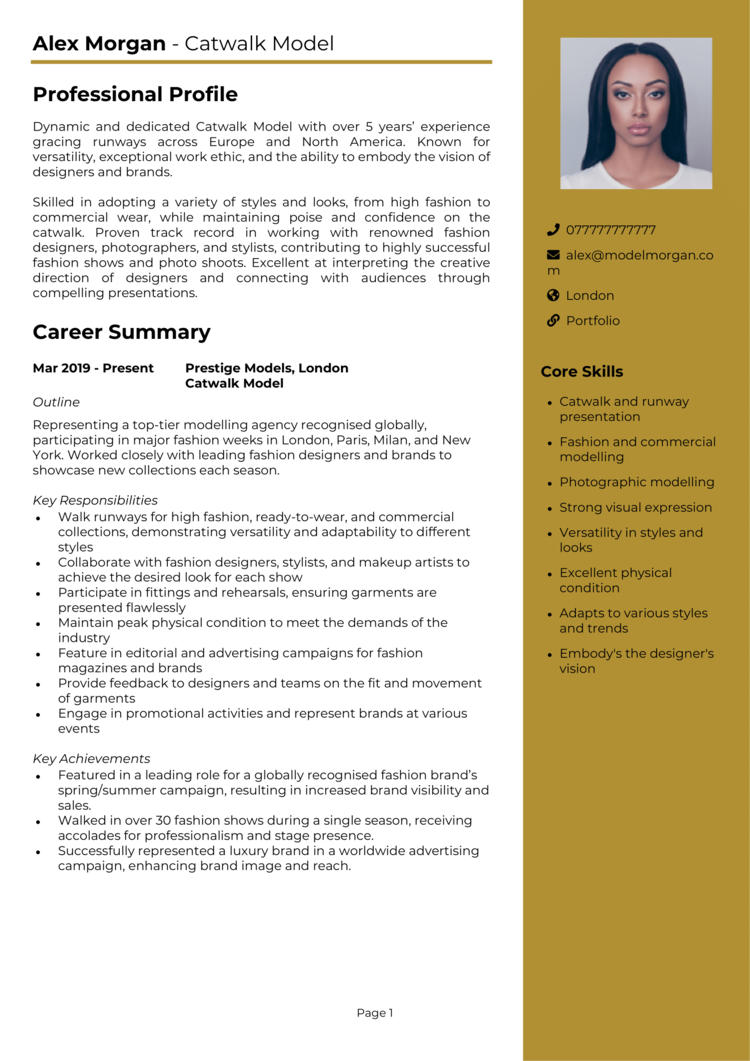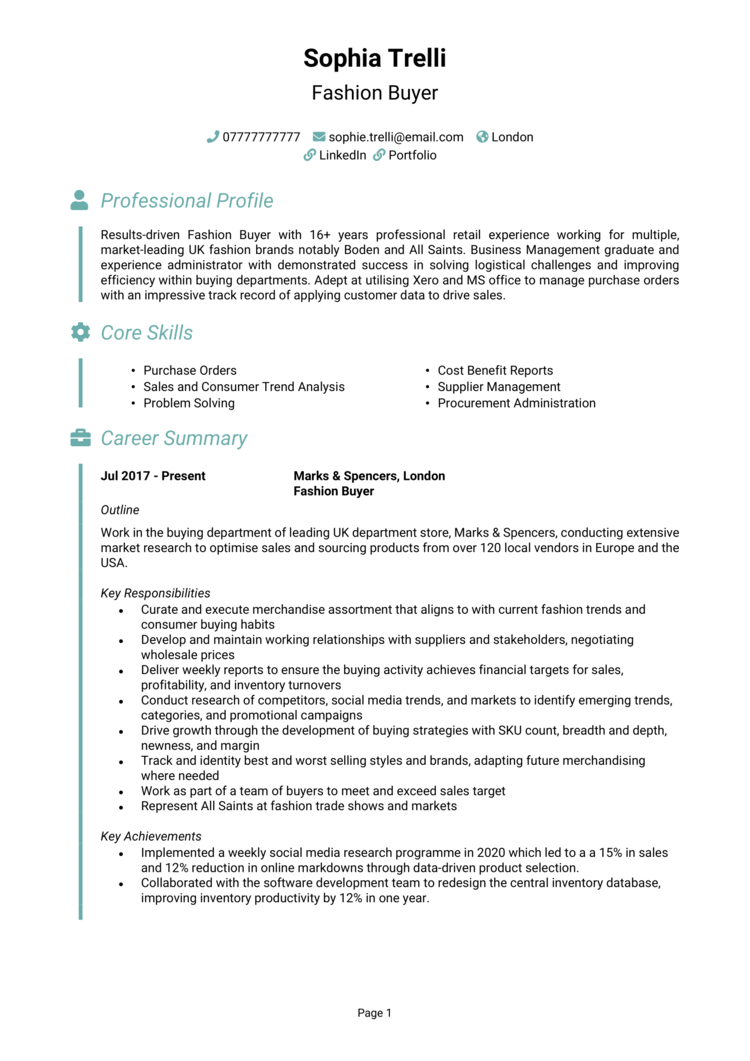Fashion is all about standing out and making a statement, and your CV should do exactly the same. Whether you’re designing the next big trend or managing a boutique’s operations, you’ll need a CV that makes hiring managers take notice.
This guide, complete with a Fashion CV example, will show you how to highlight your creativity, industry expertise, and achievements – so you can land your dream role in the ever-evolving world of fashion.
Fashion Designer CV example

Catwalk Model CV example

Fashion Buyer CV example

How to write your Fashion CV
Learn how to create your own interview-winning Fashion CV with this simple step-by-step guide.
A Fashion CV isn’t just a list of jobs – it’s your portfolio on paper. If your career were a collection, this CV would be the showstopper piece that closes the show. Employers want to see your ability to stay ahead of trends, collaborate with teams, and contribute to the success of a brand or project.
With this guide, you’ll learn how to write a CV that’s as polished and stylish as your work, helping you stand out, get interviews, and take the next step in your fashion career.
Structuring your Fashion CV


Your CV should be as sleek and well-coordinated as a high-end outfit. A clear CV structure ensures recruiters can easily spot your skills, experience, and qualifications: recruiters don’t have time for clutter – save the avant-garde designs for your portfolio, not your CV.
Here’s how to structure your Fashion CV:
- Name and contact info – Keep contact details at the top so hiring managers can reach you quickly. Including a picture of yourself is optional, but recommended for a role like this.
- Profile – Start with a summary of your expertise, key achievements, and career aspirations.
- Core skills – Showcase your abilities, from trend forecasting to client relations.
- Work experience – List your previous roles in reverse chronological order, highlighting your contributions to brands and projects.
- Education – List your academic background and any relevant certifications or training.
- Additional info – You can optionally mention hobbies and interests and awards that reflect your creativity or fashion knowledge.
Fashion CV format


Your CV format should reflect the elegance and professionalism you bring to your work. Just like mixing patterns, there’s a fine line between creative and chaotic – your layout should be stylish but professional to keep recruiters engaged and focused on your content.
Here’s how to format your Fashion CV effectively:
- Bullet points – Break down your responsibilities and achievements for quick reading.
- Divide sections – Use clear headings to separate your CV into logical parts.
- Use a clean font – Opt for a stylish but easy-to-read font to make your CV look professional.
- Keep it the right length – Two pages is plenty of length to showcase your expertise without losing the recruiter’s interest.
Creating your Fashion CV profile


Your profile is your personal brand statement, giving recruiters a snapshot of your expertise and what makes you stand out in the fashion world. You’ll need to show the benefits hiring you would bring, and hopefully convince the recruiter to keep reading.
If you’re newer to the field, opt for a longer personal statement instead, and be sure to attach a cover letter to back up your application.
Fashion CV profile examples
Profile 1
Creative Fashion Designer with five years of experience in creating innovative collections for luxury and high-street brands. Skilled in trend forecasting, garment construction, and digital design using Adobe Illustrator and CLO 3D. Proven track record of delivering seasonal collections that align with brand identity while appealing to target audiences. Experienced in managing the design process from concept to final production.
Profile 2
Dedicated Fashion Buyer with three years of experience in sourcing, negotiating, and managing supplier relationships for retail chains. Skilled in analysing market trends, planning seasonal collections, and ensuring stock aligns with consumer demand. Proficient in inventory management software and forecasting tools. Known for reducing costs while maintaining quality and profitability.
Profile 3
Organised Fashion Merchandiser with over seven years of expertise in planning and executing store layouts, optimising product placement, and driving sales through strategic visual merchandising. Experienced in working with both brick-and-mortar and online retail operations. Skilled in using data analytics tools to monitor sales performance and adjust merchandising strategies accordingly.
What to include in your Fashion CV profile
Here are some tips on what to include in your Fashion CV profile:
- Where you’ve worked – Mention brands, boutiques, or studios you’ve collaborated with.
- Your top qualifications – Highlight relevant degrees or certifications, like a fashion design degree.
- Creative expertise – Note your strengths in areas like sketching, styling, or fabric sourcing.
- Notable achievements – Mention standout accomplishments, like designing a bestselling collection or managing a successful campaign.
- Career aspirations – Reference goals that align with the role, such as growing a brand’s influence or specialising in a particular niche.
Core skills section


Your CV skills section is your chance to show recruiters exactly what you bring to the table. It’s like a carefully curated mood board – a quick snapshot of your strengths that align with the role.
A good CV will tailor this section to reflect the specific focus of the role – if it’s a design job, emphasise your creativity, while a retail role might highlight organisational and sales skills.
Remember, substance matters here. Swap vague terms like “creative thinker” for specifics like “proficient in Adobe Illustrator” or “expert in sustainable fabric sourcing.”
What are the most important skills for a Fashion CV?
- Trend Forecasting – Analysing market trends and consumer behaviour to predict upcoming fashion styles.
- Design Development – Creating original clothing or accessory designs using sketches, patterns, or digital tools.
- Textile Selection – Choosing appropriate fabrics, textures, and materials to bring designs to life.
- Pattern Making – Crafting detailed patterns for garments that ensure precise fit and structure.
- Sewing and Garment Construction – Assembling clothing pieces with accuracy and attention to detail.
- Fashion Illustration – Producing visual representations of designs to communicate concepts effectively.
- Styling – Coordinating outfits and accessories to create cohesive looks for photoshoots or events.
- Branding and Merchandising – Developing visual identities and strategies to enhance product appeal and maximise sales.
- Runway Coordination – Planning and managing fashion shows, including model lineups and outfit sequencing.
- Sustainability Practices – Integrating eco-friendly materials and ethical production methods into fashion designs.
How to showcase your work experience in your CV


Your work experience section is where your career story takes centre stage. Recruiters want to see the brands, teams, and projects you’ve worked with and how you contributed to their success.
Start with your most recent role and work backwards, focusing on experiences that are relevant to the position you’re applying for.
If you’re just starting out in fashion, highlight internships, work placements, or personal projects. Designing outfits for a student runway show or creating digital fashion illustrations for a portfolio still count as experience and can show your potential.
The best way to structure job entries on your CV

- Outline – Provide a brief introduction to the brand, company, or project, and your role within it. Mention the type of fashion work involved, such as retail, design, or styling.
- Responsibilities – Focus on the key tasks you managed, like creating garment prototypes, coordinating photoshoots, or implementing visual merchandising strategies.
- Achievements – Include measurable accomplishments, like increasing store sales through effective merchandising or designing a collection that received industry recognition. Numbers and specific outcomes are always desirable, so add metrics where possible in your CV.
Example jobs for Fashion
Designer | Luxe Product
Outline
Designed and developed seasonal collections for a luxury womenswear brand, focusing on creating trend-driven yet timeless pieces. Managed the entire design process from initial sketches to final production.
Responsibilities
- Conducted market research and trend analysis to create relevant and competitive collections.
- Sketched designs and created digital renderings using Adobe Illustrator and Photoshop.
- Collaborated with pattern makers and garment technicians to ensure design feasibility.
- Sourced high-quality fabrics and materials, maintaining relationships with trusted suppliers.
- Presented collections to senior management and buyers, incorporating feedback into final designs.
Achievements
- Increased brand visibility by designing a bestselling collection that boosted sales by 20 percent.
- Reduced production costs by 15 percent through efficient material sourcing.
- Recognised for delivering a capsule collection within tight deadlines for a major fashion week.
Buyer | Trendline Retailers
Outline
Sourced and purchased seasonal collections for a high-street fashion retailer, ensuring alignment with consumer trends and sales targets. Worked closely with suppliers and internal teams to maintain stock levels and profitability.
Responsibilities
- Analysed market trends, competitor performance, and customer preferences to inform buying decisions.
- Negotiated pricing and delivery terms with suppliers to optimise budgets and ensure timely stock availability.
- Collaborated with designers and merchandisers to plan cohesive collections for multiple product categories.
- Monitored sales data to identify bestselling items and make informed reordering decisions.
- Travelled to international trade shows and supplier meetings to source unique products.
Achievements
- Increased gross margin by 10 percent through successful negotiations with suppliers.
- Achieved a 15 percent reduction in excess inventory by refining seasonal purchasing strategies.
- Introduced a new supplier relationship that resulted in exclusive product lines for the retailer.
Fashion Marketer | StyleForward
Outline
Managed visual merchandising for a leading fashion retailer, focusing on optimising store layouts and creating engaging displays that drove footfall and sales. Supported both physical stores and e-commerce platforms.
Responsibilities
- Planned and implemented visually appealing in-store displays to highlight new arrivals and promotions.
- Collaborated with marketing teams to align merchandising strategies with advertising campaigns.
- Analysed sales data to adjust product placement and optimise stock rotation.
- Provided training to store staff on maintaining visual standards and enhancing the customer experience.
- Developed online merchandising strategies, including product photography and categorisation.
Achievements
- Boosted in-store sales by 25 percent through innovative product displays.
- Reduced stockholding costs by 15 percent by improving inventory turnover rates.
- Recognised by senior management for consistently enhancing brand aesthetics and customer engagement.
Education section


The education section highlights your academic foundation and professional training. In the fashion industry, this could mean anything from a degree in fashion design to certifications in digital illustration or textile technology.
If you’re a recent graduate, focus on coursework, projects, or internships that demonstrate your skills and dedication. Include any workshops or short courses that have expanded your knowledge, such as a masterclass in fashion marketing or sustainable design practices.
Always list your qualifications in reverse chronological order, starting with your most recent.
Best qualifications for Fashion
- Bachelor’s Degree in Fashion Design – Covers areas like garment construction, sketching, and trend forecasting.
- Certificate in Textile Technology – Demonstrates knowledge of materials, weaves, and fabric innovations.
- Digital Fashion Illustration Certification – Highlights expertise in creating technical drawings using software.
- Fashion Business Diploma – Provides insights into retail management, branding, and consumer behaviour.
- Sustainable Design Certification – Demonstrates your commitment to eco-friendly practices in fashion.





